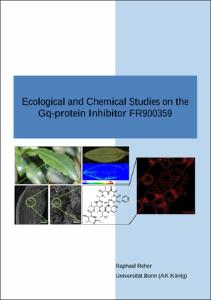Reher, Raphael: Ecological and Chemical Studies on the Gq-protein Inhibitor FR900359. - Bonn, 2018. - Dissertation, Rheinische Friedrich-Wilhelms-Universität Bonn.
Online-Ausgabe in bonndoc: https://nbn-resolving.org/urn:nbn:de:hbz:5n-52088
Online-Ausgabe in bonndoc: https://nbn-resolving.org/urn:nbn:de:hbz:5n-52088
@phdthesis{handle:20.500.11811/7644,
urn: https://nbn-resolving.org/urn:nbn:de:hbz:5n-52088,
author = {{Raphael Reher}},
title = {Ecological and Chemical Studies on the Gq-protein Inhibitor FR900359},
school = {Rheinische Friedrich-Wilhelms-Universität Bonn},
year = 2018,
month = sep,
note = {The cyclic depsipeptide FR900359 (FR), isolated from the tropical plant Ardisia crenata, displays a strong and selective inhibition of Gq proteins, making it an indispensable pharmacological tool to study Gq-related processes, as well as a promising drug candidate. Gq inhibition is a novel mode of action for defense chemicals and crucial for the ecological function of FR, as corroborated by in vivo experiments on mice, affinity to insect Gq proteins and insect toxicity studies. The uncultured endosymbiont of A. crenata, 'Candidatus Burkholderia crenata' was sequenced, revealing the FR nonribosomal peptide synthetase (frs) gene cluster. In this study we provide a detailed model of FR biosynthesis, supported by in vitro enzymatic and bioinformatic studies. Finally, expression of the frs genes in E. coli led to heterologous FR production in a cultivable, bacterial host for the first time, paving the way for a biotechnological production of FR independent from time- and work-intensive plant cultivation, harvesting and extraction.
Direct targeting of intracellular Gα subunits is a challenging task in pursuit of chemical tools for pharmacological studies and for developing novel therapeutic approaches. We isolated four new FR analogs (1-4) from A. crenata and elucidated their structures by NMR spectroscopic data and MS-based molecular networking followed by in-depth LCMS2 analysis. Next, we analyzed all currently known inhibitors of Gq protein including YM-254890, FR900359, above mentioned novel FR-derivatives from A. crenata, and synthetic cyclic peptides to devise a strategy for the elucidation of characteristics that determine interaction with Gq. Using 2D NMR spectroscopy and molecular docking we identified unique features in the macrocycles that govern specific binding to and inhibition of Gq. While all novel compounds were devoid of effects on Gi and Gs proteins, no inhibitor surpassed biological activity of FR or YM. This raises the question of whether nature has optimized these depsipeptides for specific inhibition of Gq. Thus, rather than attempting to enhance Gq activity of newly synthesized inhibitors, future synthetic efforts on FR/YM-analogs should target Gα subunits other than Gq. Additionally, FR was detected from leaves of five other Ardisia species, among them the non-nodulated A. lucida as well as from a soil bacterium, implicating a much broader distribution of FR as originally anticipated.
Furthermore the first reported fluorescent FR analogs were synthesized, biologically evaluated and applied to study the mechanism of cellular uptake of FR.},
url = {https://hdl.handle.net/20.500.11811/7644}
}
urn: https://nbn-resolving.org/urn:nbn:de:hbz:5n-52088,
author = {{Raphael Reher}},
title = {Ecological and Chemical Studies on the Gq-protein Inhibitor FR900359},
school = {Rheinische Friedrich-Wilhelms-Universität Bonn},
year = 2018,
month = sep,
note = {The cyclic depsipeptide FR900359 (FR), isolated from the tropical plant Ardisia crenata, displays a strong and selective inhibition of Gq proteins, making it an indispensable pharmacological tool to study Gq-related processes, as well as a promising drug candidate. Gq inhibition is a novel mode of action for defense chemicals and crucial for the ecological function of FR, as corroborated by in vivo experiments on mice, affinity to insect Gq proteins and insect toxicity studies. The uncultured endosymbiont of A. crenata, 'Candidatus Burkholderia crenata' was sequenced, revealing the FR nonribosomal peptide synthetase (frs) gene cluster. In this study we provide a detailed model of FR biosynthesis, supported by in vitro enzymatic and bioinformatic studies. Finally, expression of the frs genes in E. coli led to heterologous FR production in a cultivable, bacterial host for the first time, paving the way for a biotechnological production of FR independent from time- and work-intensive plant cultivation, harvesting and extraction.
Direct targeting of intracellular Gα subunits is a challenging task in pursuit of chemical tools for pharmacological studies and for developing novel therapeutic approaches. We isolated four new FR analogs (1-4) from A. crenata and elucidated their structures by NMR spectroscopic data and MS-based molecular networking followed by in-depth LCMS2 analysis. Next, we analyzed all currently known inhibitors of Gq protein including YM-254890, FR900359, above mentioned novel FR-derivatives from A. crenata, and synthetic cyclic peptides to devise a strategy for the elucidation of characteristics that determine interaction with Gq. Using 2D NMR spectroscopy and molecular docking we identified unique features in the macrocycles that govern specific binding to and inhibition of Gq. While all novel compounds were devoid of effects on Gi and Gs proteins, no inhibitor surpassed biological activity of FR or YM. This raises the question of whether nature has optimized these depsipeptides for specific inhibition of Gq. Thus, rather than attempting to enhance Gq activity of newly synthesized inhibitors, future synthetic efforts on FR/YM-analogs should target Gα subunits other than Gq. Additionally, FR was detected from leaves of five other Ardisia species, among them the non-nodulated A. lucida as well as from a soil bacterium, implicating a much broader distribution of FR as originally anticipated.
Furthermore the first reported fluorescent FR analogs were synthesized, biologically evaluated and applied to study the mechanism of cellular uptake of FR.},
url = {https://hdl.handle.net/20.500.11811/7644}
}






